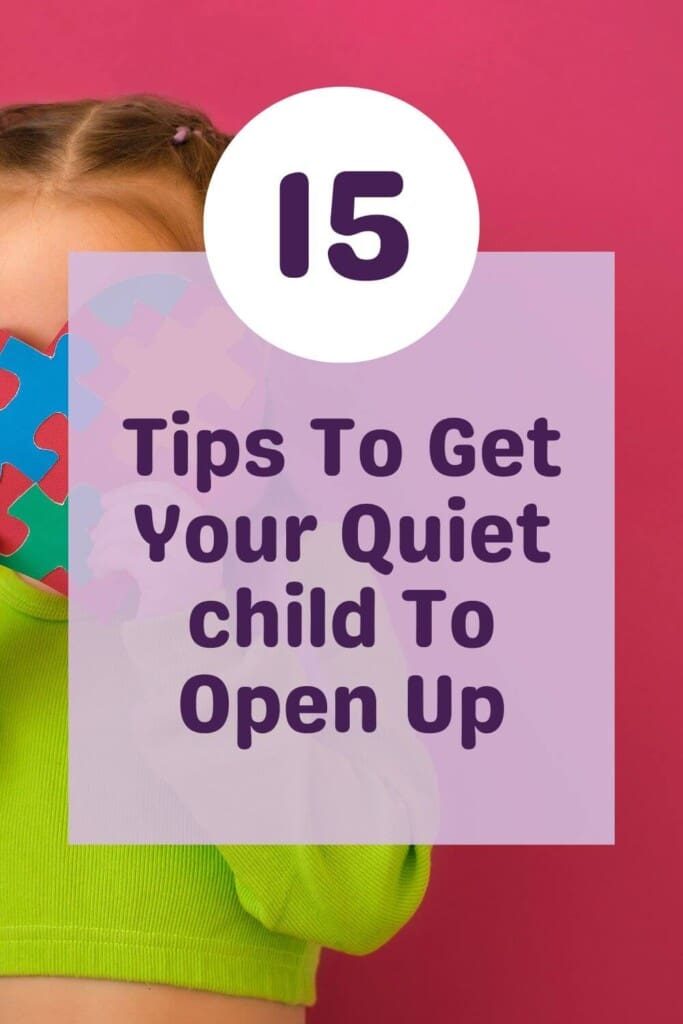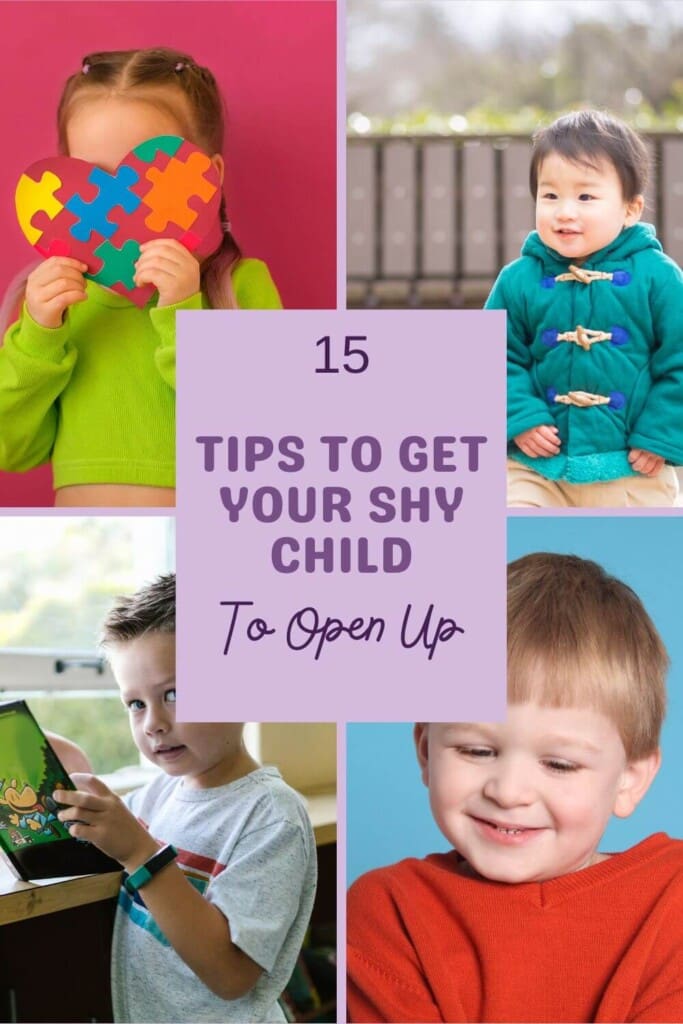How to Help a Shy Child Open Up: 15 Effective Parenting Tips
Shyness isn’t a flaw — it’s a temperament. Many children naturally feel hesitant in unfamiliar situations, and that’s completely okay. But as a parent, it can be tough when your child clams up around others or struggles to express themselves even at home.
If you’re wondering how to help a shy child open up, you’re in the right place. I’ve walked this journey with my own quiet kids — and through trial, error, and a lot of learning, I’ve collected practical, gentle ways to encourage openness without pushing too hard.
Let’s explore 15 proven strategies to support your child in becoming more comfortable, expressive, and confident in their world.
Heads up: This post may include affiliate links. As an Amazon Associate, I earn from qualifying purchases—at no extra cost to you. Full privacy policy and disclosure here.

1. Accept Their Temperament Without Judgment
Understanding how to help a shy child open up starts with empathy, not pressure.
Before diving into tips, the first step is acceptance.
Your child might not be talkative at playdates or jump into group activities. That’s okay. Shyness is not a problem to be fixed — it’s a temperament to be understood. Start by saying things like:
“I love how thoughtful you are. You don’t have to talk a lot to be amazing.”
This helps build trust, which is essential if you’re trying to help your shy child open up.
2. Create Safe Spaces for Expression
Children open up when they feel emotionally safe. That often means keeping your reactions calm and supportive, especially when your child shares something vulnerable.
Designate a calm, screen-free space at home where your child can decompress or chat with you one-on-one. Bonus: Add cozy touches like this Comfy Floor Cushion Set to make the space inviting.
3. Practice Open-Ended Conversation Starters
In my experience, one of the best ways on how to help a shy child open up is to create a predictable, low-stress routine
Instead of yes/no questions, use open-ended ones like:
- “What was your favorite part of the day?”
- “If you could be any animal today, which one would you be?”
These make it easier for shy children to express themselves without pressure.
Want more ideas like this? Check out Encouraging Words for Kids for helpful conversation starters and affirmations.
4. Use Books to Spark Connection
Parents often search for how to help a shy child open up, but the answer lies in consistency, not quick fixes.
Books with relatable characters help kids process emotions and see themselves reflected.
Some excellent choices include:
- “The Invisible Boy” by Trudy Ludwig – A beautiful story about inclusion and friendship.
- “What to Do When You Feel Too Shy” – A workbook that helps kids process and overcome social anxiety.
- “Be Brave Little One” by Marianne Richmond
Make story time interactive. Ask, “Do you ever feel like that?” to gently encourage personal sharing.
5. Avoid Labels (Even Positive Ones)
When considering how to help a shy child open up, remember that every child blooms on their own timeline.
While saying “She’s just shy” may feel like you’re protecting your child, it can actually reinforce their reluctance to speak up.
Instead, describe behavior:
“She likes to take her time before jumping into new situations.”
This reframes shyness as thoughtfulness — not a fixed trait.
6. Practice Role-Playing
The strategies below are grounded in real-life experience and offer actionable steps on how to help a shy child open up at their own pace.
Role-play real-life scenarios like meeting someone new, ordering food at a restaurant, or responding to a birthday party invitation.
Use toys or stuffed animals if your child feels more comfortable acting through them.
You can even grab this Melissa & Doug Role Play Costume Set to add more fun and imagination to your pretend play sessions.
7. Respect the Warm-Up Time
These gentle, connection-based approaches will show you exactly how to help a shy child open up while respecting their personality.
Some kids need 10–15 minutes (or longer) to settle into a social setting. Don’t rush them. Instead, give them a heads-up about what to expect.
Let them bring a comfort item or allow observation before participation.
Learning how to help a shy child open up means giving them space to ease in — not forcing extroversion.
8. Model Vulnerability
When your child sees you expressing your own emotions and talking through challenges, they’re more likely to do the same.
Say things like:
“I felt nervous making that phone call today, but I took a deep breath and did it anyway.”
This normalizes big feelings and shows how to work through them.
9. Focus on Strengths
Shy kids are often great listeners, deep thinkers, and wonderfully empathetic. Highlight those traits!
You could say:
“I noticed how kind you were to your little sister when she felt sad. That was really thoughtful.”
Want more on this? Visit Powerful Words of Affirmation for Children to build your child’s inner narrative.
10. Use Gentle Affirmations
Quiet children often benefit from regular, low-pressure confidence boosts. Try phrases like:
- “You’re allowed to take your time.”
- “Your voice matters.”
- “It’s okay to feel unsure.”
You can even display them visually. We use this Affirmation Card Set for Kids — it’s fun, visual, and helps build daily confidence.
11. Encourage Group Activities (With Boundaries)
Enroll your child in a small group class where they can engage in low-pressure social interactions — like art, robotics, or nature walks.
Look for programs that:
- Keep class sizes small
- Offer parent-observer options
- Focus on individual creativity, not competition
12. Let Them Contribute at Home
Assigning your child age-appropriate responsibilities helps them feel capable and seen. Even simple jobs like setting the table or feeding the pet can foster confidence.
Tip: Involve them in planning meals or decorating their room to help them feel heard and empowered.
For more ideas on building confidence, don’t miss 5 Great Tips to Help Kids Gain Body Confidence.
13. Help Them Prepare for Transitions
Talk about upcoming events or changes ahead of time to help your child mentally prepare.
For example:
“At the party, we’ll say hello to the birthday girl, then you can decide if you want to play or just stay near me.”
Knowing what to expect reduces anxiety and creates a sense of control.
14. Celebrate Small Wins
Did your child raise their hand in class today? Say hi to the neighbor?
Celebrate it!
“I saw how brave you were today — you didn’t rush, but you tried something new, and I’m proud of you.”
Consistency matters. Small wins build lasting confidence.
15. Be Patient and Stay Consistent
Helping a shy child open up is not a one-time fix — it’s a journey. You might not see instant change, but that doesn’t mean you’re not making progress.
Your steady, respectful presence is the foundation your child needs to bloom.
🛍️ Amazon Affiliate Product Recommendations
Incorporate these products with your Amazon affiliate ID (tmsp29-20) into your content:
- Books:
- Quiet Power: The Secret Strengths of Introverts by Susan Cain
- The Shyness and Social Anxiety Workbook for Teens by Jennifer Shannon
- Games and Activities:
- The Ungame – Kids Version: A non-competitive game that encourages sharing and self-expression.
- Feelings Flashcards: Helps children identify and express emotions.
- Therapeutic Tools:
- Weighted Lap Pad: Provides calming sensory input for anxious children.
- Mindfulness for Kids Cards: Activities to promote relaxation and awareness.
🧠 Expert Insight & Resources
If your child’s shyness seems extreme — for example, if they freeze in nearly all social situations or experience intense anxiety — you may want to explore professional guidance.
According to Better Health Channel, early intervention can be helpful for kids who struggle beyond typical shyness.
And Zero to Three notes that temperament doesn’t define future success — your support is the key ingredient.
❓ FAQ: How to Help a Shy Child Open Up
If you’ve been wondering how to help a shy child open up, small daily actions can make a big difference over time.
What age do shy tendencies typically appear?
Shyness can show up as early as infancy in the form of slow-to-warm-up behaviors. It often becomes more noticeable in toddlerhood and early school years.
Should I push my shy child to be more social?
Gentle encouragement is helpful, but pushing can backfire. Invite, model, and support — but never shame or force.
Are there signs that shyness is more than a personality trait?
Yes — intense fear, physical symptoms (nausea, headaches), or avoidance of nearly all social settings may point to social anxiety. In that case, consult a pediatric psychologist.
How long does it take for a shy child to open up?
Every child is different. It could be weeks or months. Stay consistent and celebrate even the smallest signs of growth.
Can shyness be a strength?
Absolutely. Shy children are often perceptive, thoughtful, and empathetic — qualities that serve them well in friendships, academics, and adulthood.
✅ Free Printable Checklist
Want a quick-reference guide to support your child every day?
Download this free printable checklist with practical steps on how to help a shy child open up — perfect for your fridge, planner, or parenting binder.
Love this post? Pin it!

